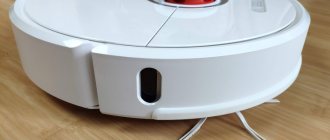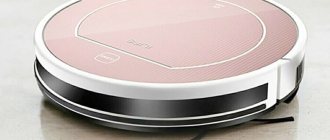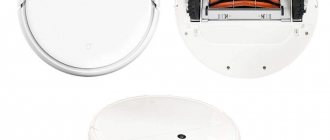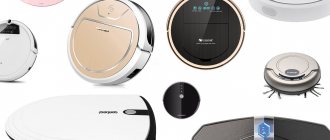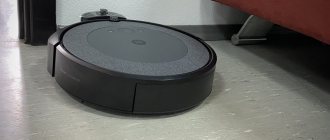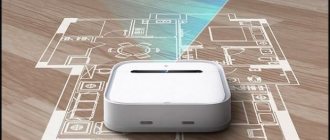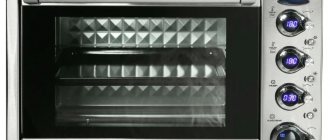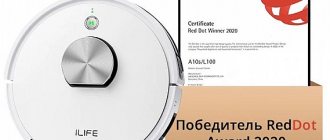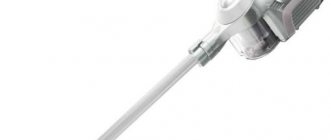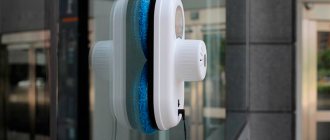Photo: flickr.com
Tired of regularly walking around the house, dragging a bulky and noisy vacuum cleaner? There is a modern solution that will simplify cleaning and reduce the time you are used to spending on it. We are, of course, talking about a robot vacuum cleaner. Their range is huge - putting aside the Chinese “no-name” and ultra-expensive innovative equipment, it is reasonable to focus on Xiaomi devices. The company has achieved good results in this segment, offering consumers effective robots at reasonable prices. But how to choose the best model from Xiaomi in 2021? We have prepared for you a detailed top 10 with reviews of the main characteristics of these electronic assistants.
The best Xiaomi robot vacuum cleaners by price/quality 2020-2021
Xiaomi Dreame F9
Smart robot vacuum cleaner based on a brushless motor manufactured by Nidec . Created for
dry and wet cleaning. Users in 2021 noted the undeniable advantage of this technique - V-SLAM technology.
It involves simultaneous localization and construction of a map in an unknown space, updating maps in a previously known environment while simultaneously monitoring the current position and the path traveled.
The technology is quick to think because it can plan a route and update data more than 50 times per second.
The system has three levels of water supply to clean different floor coverings and types of cleaning. Antibacterial flexible cloth kills up to 99.9% of germs.
Management occurs through the application . In this case, the robot will always move in a given direction, avoiding collisions with furniture, falls and impacts.
Thanks to the presence of fifteen sensors, the device easily adapts to even the most complex layout.
Characteristics:
- container volume for dust - 0.40 l, for water - 0.20 l;
- suction power - 40 W;
- battery life - up to 150 minutes;
- noise level - 65 dB.
pros
- high-quality cleaning;
- long battery life;
- long lasting battery;
- good wet cleaning performance;
- easy penetration into hard-to-reach places;
- quiet work.
Minuses
- inconvenient to maintain water container;
- flimsy attachment of attachments.
Xiaomi Mi Robot Vacuum-Mop P
A stylish room cleaner capable of not only collecting garbage, but also wiping floors to remove germs.
A system of a dozen sensors led by a lidar is responsible for its movement. It scans the space, building an accurate map. Then he moves without hitting obstacles, bumps or falls.
Designed to clean a house up to 180 square meters. m, and copes with its task in just two hours .
Control takes place through the Mi Home application. Here the user has access to a list of device capabilities.
For example, cleaning can be set up according to a schedule . The vacuum cleaner automatically activates on the specified day and time. Thanks to the cyclonic dust collector, the collected dirt is processed efficiently.
There will be no unpleasant odors left in the room . The HEPA fine filter allows you to destroy dangerous microbes.
The kit includes a charging station, microfiber, and turbo brush . The latter is designed for collecting wool and hair from various floor coverings.
The main feature is quiet operation, since the noise level reaches 55 dB.
Characteristics:
- container volume for dust - 0.55 l, for water - 0.20 l;
- suction power - 33 W;
- battery life - 150 minutes;
- number of driving modes - 3.
pros
- precise cartography;
- high-quality combined cleaning;
- good suction power;
- equipment;
- HEPA filter;
- long battery life.
Minuses
- difficulties when starting wet cleaning;
- incorrect operating algorithm.
Xiaomi MiJia Sweeping Robot G1
A budget option for a robotic cleaner for collecting garbage and washing floors . Equipped
Dual front brushes and a turbo brush for more thorough cleaning of peripheral areas.
To activate the wet cleaning mode, just pour water into a special container and attach the microfiber nozzle.
Liquid is supplied automatically to the optimal distance.
The vacuum cleaner is oriented using transmitted readings from the gyroscope and odometers, IR sensors, and fall sensors.
At the same time, it can easily overcome obstacles up to 17 mm high . In an hour and a half, the device does an excellent job of cleaning a room with an area of up to 50 square meters. m.
Control occurs through the Mi Home mobile application via a wireless Wi-Fi network and a voice assistant.
The robot cleans according to a schedule . It is programmed by days of the week, has a built-in clock, cleaning time limitation, and a timer. If there is not enough charge, it will return to the station on its own. Then he will continue his work.
Characteristics:
- container volume for dust - 0.60 l, for water - 0.20 l;
- suction power - 25 W;
- noise level - 65 dB;
- Battery life is up to 90 minutes.
pros
- fast, high-quality cleaning;
- easy controls;
- extensive programming settings;
- presence of a soft bumper;
- independent return to base;
- equipment.
Minuses
- sensors do not read black;
- no map saving.
Xiaomi Viomi Cleaning Robot V3
Multifunctional robot vacuum cleaner with laser rangefinder for precise navigation around the perimeter of the room.
The collected data is processed by SLAM algorithms, so an accurate map of the home is built. The cartography system is designed to create up to three maps.
A distinctive feature of the model is the presence of three replaceable containers: one is intended for water and wet cleaning, the second is for dry and wet cleaning, the third is presented in the form of a traditional dust collector.
At the same time, three hours are given to clean the room, which is considered an advantage compared to similar equipment.
When the charge level is low, the robot will go to the station on its own.
You can select settings and control the device through the Mi Home mobile application.
Here you can select suction power, water supply speed, and zone detection in a particular room.
Additional control occurs through a voice command using the Google Assistant, Amazon Alexa and Yandex Alice applications.
Characteristics:
- container volume for dust and water - 0.55 l each;
- suction power - 40 W;
- battery life - 170 minutes;
- number of cleaning modes - 7.
pros
- capacious containers;
- simple maintenance;
- easy controls;
- good cleaning and wet cleaning performance;
- accurate execution of tasks;
- presence of height sensors;
- extensive settings options.
Minuses
- noise at high power;
- weak battery.
Review of the Xiaomi Mi Robot Vacuum robot vacuum cleaner
Content:
- Specifications, delivery set and price
- Appearance
- Operation
- Testing
- conclusions
Specifications, delivery set and price
| Kinematic system | Two drive wheels, one support swivel roller |
| Dust collection method | Inertial movement and vacuum filtration |
| Dust collector | One compartment |
| Main brush | One: petal-bristly |
| Side brushes | One |
| Additionally | Elastic fixed scraper |
| Cleaning modes | Automatic with return for recharging, local, scheduled |
| Cleaning efficiency | Up to 250 m² on one charge |
| Noise level | No data |
| Obstacle sensors | Infrared Scanning Laser Rangefinder (LiDAR), Mechanical Front/Side Bumper, Front Ultrasonic Sensor, IR Height Sensors, Side IR Sensor |
| Orientation sensors | Lidar, odometer, gyroscope, accelerometer, electronic compass |
| Controls on the body | Mechanical buttons |
| Remote control | From a mobile device over the Internet |
| Alert | LED status indicators, voice notification |
| Battery life | Up to 2.5 hours in standard mode |
| Charging time | No data |
| Charging method | On charging base with automatic return |
| Battery | Li-ion battery, 14.4 V, 5200 mAh, 74.88 Wh |
| Power consumption | 55 W |
| Weight | 3.8 kg |
| Dimensions (diameter×height) | ∅345×96 mm |
| Peculiarities | Creating a map and choosing the optimal cleaning route, magnetic motion limiter |
| Contents of delivery* |
|
| Link to manufacturer's website | www.mi.com |
| Declared price on the manufacturer's website | 1699 yuan (approximately $250) |
| Xiaomi Mi Robot Vacuum in Gearbest.com store | Original Xiaomi Mi Robot Vacuum (White) |
| Average price according to Yandex.Market | T-14260832 |
| Offers based on Yandex.Market data | L-14260832-10 |
Appearance
The developers of Xiaomi Mi Robot Vacuum without much embarrassment borrowed the design of components and operating principles from robotic vacuum cleaners that have been on the market for a long time.
At a minimum, the Roomba (see, for example, the article about the iRobot Roomba 980) and Neato (see, for example, the article about the Neato Botvac Connected) served as donors. Of course, there are, it seems to us, original solutions. The vacuum cleaner has an almost perfectly round shape in plan.
The bevel from the edge to the bottom helps to overcome obstacles, and some angularity at the top and a slightly pronounced lip on the bumper reduce the likelihood of the vacuum cleaner getting stuck under obstacles with little clearance.
The body is made of white plastic with a matte surface without coating. On the one hand, this is good, since a light-colored robot is visible in the dark and on a dark floor, so it is easier to find it, for example, under a sofa when it gets stuck there, and the robot is less likely to be accidentally stepped on; on the other hand, the white matte bottom is easy gets dirty and difficult to clean. The upper surface of the lid, which covers most of the top panel, is also white, but mirror-smooth. In the front part there is a control panel with a mechanical rocker button, the rim of which is illuminated in white, orange or red, statically or with certain dynamics depending on the current state, a blue Wi-Fi connection status indicator and a tiny reset button. When the top cover is closed, only the rocker button remains accessible.
There is no handle for carrying the robot. The top cover covers not only part of the control panel, but also the dust collector compartment.
There is a mechanical bumper installed in front, which covers the entire front part of the robot and extends to the sides.
Behind the grille in the center of the bumper there is an ultrasonic proximity sensor. On the right side of the bumper there is an oval cutout, behind which there is an auxiliary IR obstacle sensor, which helps the robot move close to the obstacle (it is stated that at a distance of 10 mm), if possible without physical contact with it.
At the rear of the case there is an “exhaust” grille (right) and a grille (left), behind which there is apparently a loudspeaker, and in the center there are contact pads for charging on the base.
Turning the vacuum cleaner upside down, we will see four IR height difference sensors (dark windows along the edge in front and in front of the drive wheels), a roller on a rotating platform, a side brush, a compartment with the main brush, closed by a frame with limiting guides (carpet corners are not wound up) and with an additional elastic fixed scraper, and two drive wheels on spring-loaded levers. An inconspicuous lid hides a Micro-USB connector, apparently used for diagnostics and a contact method for updating the firmware.
The base is relatively large and not very light.
The base body is made of white plastic with a mostly matte surface. Two rubber anti-slip pads are glued to the bottom of the base.
The bottom area is increased due to the supporting protruding skirt. As a result, the base is quite stable and can be installed on the floor without any additional support. On the front panel of the base there is a large window made of tinted translucent plastic, behind which there are passive parking beacons (alternating strips of absorbing and reflective material). Below are long spring-loaded contact pads.
This design guarantees reliable contact between the robot and the base even when parking is slightly crooked. When pressed, the contact pads not only recess, but also move sideways, which helps clean the contacting surfaces. The power supply is built into the base. The power supply cable is detachable (uses a two-pin connector with cylindrical contacts). Excess power cable is stored in a special channel at the back of the base.
And for beauty and to reduce dust, all this is closed with a lid.
The measured length of the power cord was 1.5 m (length of the flexible part). Database characteristics: input - 100-240 V 50/60 Hz, output - 20 V DC up to 2.2 A.
There are no additional accessories or consumables included in the package, everything is minimal.
There is documentation - a printed manual and a brief reference, all, unfortunately, in Chinese. The vacuum cleaner is packaged in a not very large, modestly decorated box with a plastic handle.
Operation
For those who know Chinese, we recommend reading about the vacuum cleaner's functions in the included user manual. Those who don’t know will either have to look for a translation of the manual (we couldn’t find one) or translate it themselves, for example using a mobile application.
The robot is equipped with an orientation system based on an infrared scanning laser range finder (lidar). The lidar is installed in a turret on the top panel. Through the horizontal “loopholes” of this turret you can see the lenses of the emitting laser diode and photodetector. The laser diode and photodetector are mounted on a rotor that rotates in a horizontal plane, and this is what allows the robot to obtain data on the distance to obstacles with a 360-degree horizontal view 5 times per second. The manufacturer also indicates that the scanning frequency is 1800 samples per second, the distance to the obstacle is determined at a distance of up to 6 m with an accuracy of 2%. That is, unlike most models, the robot does not have to approach the obstacle closely to determine its presence. In addition, remote detection of obstacles and their geometry allows the robot to map the room and track its own location. The robot “knows” where it is, where the base station is (when launched from it), where it has already cleaned, where it needs to be cleaned, and where there are still unexplored areas in the perimeter of the territory.
In theory, a changing environment - moving pieces of furniture or walking people and non-people - can confuse the robot's orientation, but in practice walking around the robot is not forbidden; apparently, there is some kind of algorithm for discarding obstacles that are not constant in time. You also need to take into account that the lidar operates in a plane at a certain height from the floor, that is, the robot “does not see” everything that is lower or higher. However, in the “lower” case, the robot is equipped with a mechanical bumper and an ultrasonic obstacle sensor on it. The option of obstacles located above the plane of action of the lidar, in theory, can lead to some problems, since the roof of the turret is located above this plane. Note that the height of the robot, even with a turret, is not very large (we got 81 mm to the top of the bumper and 95 mm to the top of the turret), which increases the area available for cleaning.
The axles of the drive wheels are located on the same diameter (350 mm) of the body circumference. This kinematic scheme allows the robot to turn on the spot without changing the boundaries of the area occupied by the robot, so the vacuum cleaner has good maneuverability. The diameter of the drive wheels is relatively large (70 mm), and the stroke of the hinges at the wheel centers reaches almost 30 mm, so the robot can overcome obstacles of small depth and height without any problems. These wheels have a deep tread made of a non-slip rubber-like material. Potentially, the robot is capable of overcoming obstacles up to 18 mm in height - approximately the same distance from the floor to the bottom point of the vacuum cleaner’s bumper, which is consistent with cross-country ability, that is, the robot will not try to climb onto something that is likely to get stuck. The robot weighs 3.8 kg.
When cleaning, the front side brush sweeps debris toward the center. Let's note the design of the side brush - flexible elastic leads (stitched at the ends for strength) end with relatively stiff straight bristles. As a result, the brush works effectively and does not lose its shape. The original element is a small tuft of bristles on the side surface of the brush sleeve; apparently, this should prevent hair, threads, etc. from getting tangled. on the brush axis.
The main brush should cope with the task of combing out and throwing debris from the surface to be cleaned. Next, the debris is sucked by the air stream into the dust collector container, where it, the debris, is retained by the filter. After passing through the fan, the air, having served its purpose as a carrier, is expelled back through the grille at the rear of the robot. This model is not a vacuum cleaner in the classical sense, since almost no debris is sucked directly from the surface being cleaned (except very light dust).
The end of the main brush rotates in a sliding bearing, protected from hair and dirt by a plastic casing. Note that there are still the same tufts of bristles on the frame, which are designed to protect the drive and brush bearing from debris getting into them.
The delivery set includes a special tool with a comb and a squiggle blade. You can use it to cut off tangled hair and comb it out with a brush.
The compartment in which the main brush is installed is mounted on levers, so with a stroke of approximately 9 mm at the edge distant from the axes of the levers, it follows the topography of the floor, which increases cleaning efficiency.
The dust collector body is made of transparent plastic. However, the top panel cover is opaque, so without lifting it, it is impossible to assess the actual filling of the dust container. There appears to be no dust bin overflow sensor; the volume of the dust bin is relatively small, so the user will have to look under the lid frequently. There is a lid on the front of the dust container that needs to be opened when cleaning this container. The rear end of the dust collector is plugged with an air filter. To eliminate parasitic air leaks, the joints of the pipe and the dust collector, as well as the filter and the suction grille, are equipped with elastic seals. Judging by the crossed out droplet, the dust collector is prohibited from washing.
The robot monitors the presence of a dust collector in its compartment, or rather a filter on it, for which a small magnet is attached to the filter frame, and there is a corresponding sensor in the compartment. The folded, finely porous filter is protected by a large-mesh plastic mesh that traps large debris. Without this mesh, the folds of such filters become clogged with debris, which is difficult to clean out.
The manufacturer boasts of a powerful fan installed in the robot with a brushless motor from the Japanese company Nidec. It is stated that the peak performance of the fan reaches 0.67 m³/min, and the maximum vacuum is 1800 Pa.
The powerful fan is matched by a capacious battery. To get to it, you need to unscrew six screws on the bottom, one of which is under the seal, and remove it.
Most likely, the battery pack is made up of cylindrical elements of the popular 18650 standard size, but we did not disassemble the battery, since there seems to be no way to do this without significant damage to the appearance. The removed bottom demonstrates that the drive wheel, main and side brush modules are easily replaced if necessary.
We would like to warn you that this vacuum cleaner should not be used in a damp room or on surfaces with spilled liquids. After the vacuum cleaner comes into contact with liquids, in the best case, it will take a long time to clean it from the adhering layer of dust, and in the worst case, the vacuum cleaner may fail.
As far as we could understand, this model has two main cleaning modes:
- Single (double for small rooms) cleaning of the entire accessible area.
- Cleaning a specific place - the vacuum cleaner is moved to the desired place.
Automatic start of cleaning ensures scheduled operation - in the application you can specify the day/days of the week and time when you want to start cleaning.
According to the manufacturer, when starting from the base, the robot will clean either until it has cleaned the entire available area, or until the battery charge drops below 20%. In the second case, it will return to the base, charge the battery, then continue cleaning from where it left off. It is not specified how many cleaning cycles with intermediate recharges the robot can do.
Spatial planning of cleaning is ensured using a magnetic limiting tape (25 mm wide and 2 mm thick), which can simply be placed on the floor or hidden under the (probably still thin) floor covering. Unfortunately, the manufacturer was stingy in including the tape in the package, you will have to buy it additionally, and, for example, Gearbest.com offers the Original Xiaomi Virtual Wall, apparently 2 m long, for $16.63 with free shipping.
The vacuum cleaner informs about its condition using an LED indicator - a rim around the rocking button - as well as by pronouncing words, phrases and even long sentences in pure Chinese. If desired, this voice notification can be turned off, but only together with the ability to start cleaning.
This option, like many other functions, is available from a proprietary application installed on mobile devices with Android (apparently iOS) on board. There is no official Russian version of the application, but if you wish, you can find and install an unofficial version translated into Russian from the APK file (although you will have to tinker a little more in order to also install the plugin translated into Russian, designed to control the robot vacuum cleaner). Most of the screenshots shown here were taken specifically for this Russified version of the application and plugin.
Having launched the application for the first time, you need to establish a connection with the robot, which must be within range of a Wi-Fi network (and, apparently, only 2.4 GHz) with access to the larger Network, since a global cloud service is used to control the robot. On the one hand, this is good, since you can control the robot from anywhere there is a connection to the Network, on the other hand, it is bad, since if there is no access to the Network or there is not at least a connection with a cloud service (and this happens all the time), then there is no access to the robot, even if it and the mobile device are on the same local network. From our point of view, the most useful function is the display of a map of the room compiled by the robot and the trajectory of the robot’s movement on it. You can control how the robot cleans and, if necessary, make adjustments to the arrangement of furniture, etc. in order to improve the quality of cleaning. The main page of the plugin displays the status of the robot, a map, the area cleaned and the time for the last cleaning performed, as well as the current battery charge. At the bottom there are buttons to return to the base, start cleaning and switch the fan power.
At the top right is a button to go to pages with additional settings.
Testing
Below are the test results using our methodology, described in detail in a separate article.
| Fan power | Launch | Cleaning time, min:sec | % |
| Maximum* | 1 | 16:37 | 98,0 |
| Maximum* | 2 | 15:51 | 98.9 (total) |
| Maximum* | 3 | 14:18 | 99.1 (total) |
| Silently | 1 | 15:43 | 90,8 |
| Silently | 2 | 16:47 | 99.2 (total) |
* Additionally, the Full Power option is included.
The video below was shot from above from one point, the base is located at the bottom center, during processing part of the video sequence was accelerated ten times, Maximum mode with the Full power option enabled:
In the case of our test area, at the beginning of cleaning, the robot walks around the perimeter of the area available for cleaning, and then, moving like a snake, passes through the interior of the territory. The robot performed these procedures twice, which, apparently, is supposed to be done for small rooms. The constructed map and movement trajectory are shown below.
The green dot is the location of the robot and charging base. The robot easily enters narrow spaces that are only 50 mm wider than the robot body and cleans there. When approaching an obstacle frontally, the robot slows down a few centimeters before it, but usually continues to move until it touches the bumper and the bumper movement sensors are triggered. If the obstacle moves easily, for example, a curtain, the robot moves it a few centimeters (the bumper sensors do not work), but then still turns away from the obstacle. While moving along an obstacle that reflects IR light well, the robot moves sideways close to the obstacle, but does not touch it. And if the obstacle does not reflect IR light well, then periodic contact with the side of the bumper occurs. When walking around the perimeter or along an obstacle, the robot increases the speed of rotation of the side brush. The video and map show that the robot's navigation system often malfunctions, and the robot strangely circles the two bottom corners. We cannot even guess what this is connected with. Sometimes the snake crawl became diagonal relative to the walls of the fenced area, this can be seen in the video below (Silent mode, first pass):
For some reason, this affected not only the type of trajectory, but also the quality of cleaning, since the robot left a corner uncleaned during the first pass, as can be seen on the map:
This behavior with a diagonal walk was repeated until we removed the robot from the base and returned it back, thereby apparently resetting its binding to the known room. The robot handles the base very carefully; it removes close to it, but does not touch or move the base from its place. Upon completion of cleaning, the robot switches the suction fan and brush drives to low power mode, then quickly, purposefully and as quickly as possible moves to a place in front of the base, turns at some distance from it with its back part with contacts to the base, slowly approaches it and, performing oscillating movements, slowly docking. A rough determination of the location of the base is apparently carried out using a compiled map, but precise docking is carried out using passive beacons on the base itself. The robot can search for a database at the user's command, even if it was not launched from it.
Overall, the robot cleans quickly and efficiently. Turning on the low power fan mode Silently has almost no effect on the quality of cleaning (the uncleaned corner had a greater effect), at least for our test debris. After the first cleaning cycle, a little debris remains near obstacles and in small areas in the corners where navigation fails, near the base the robot cleans very well:
After two more cycles, very, very little garbage remains (99.1% removed):
In the first local cleaning test, the robot lost orientation due to black and almost non-reflective walls. The two boxes helped him stay grounded, and the cleanup was completed successfully. The process is shown in the video below:
According to the manual, the size of the cleaned area is 1.5 by 1.5 m, which is approximately what happened. A magnetic insert strip from the refrigerator door seal works as a magnetic limiter, but we did not find out exactly what orientation of magnetization is needed and whether it plays a role.
Additionally, full-scale tests were carried out. To do this, an area of several rooms with a total area of approximately 110 m² was fenced off in an office and relatively clean room. The layout of the room is shown below. On it, colored rectangles mark the rooms accessible to the robot and a red circle marks the location of the base.
The robot snaked away the entire available area. Upon completion, the robot purposefully and by the shortest route returned to the base to recharge. On the map below you can see how the robot cleaned the path from the last room to the base:
The robot cleaned for 93 minutes. In the case of such a large room, the robot divides it into sections measuring approximately 3.5 by 3.5 m, repeating the same cycle in each - walking around the perimeter of the section, then snaking around the inner area of the section and moving on to the next section. Like all robots with navigation that we tested, Xiaomi Mi Robot Vacuum does not operate with such concepts as room and walls, from its point of view there is some kind of accessible area and obstacles in it, how the robot will bypass this area is determined by the procedure for detecting obstacles and the algorithm cleaning, the robot does not divide the area into real rooms. According to the data from the application, the cleaned area was 84 m², but recall that from the 110 m² we indicated, we need to subtract a significant area occupied by furniture and equipment. According to data from the application, the work was completed with cleaning with a charge of 38%, but due to problems with updating information, this data may be unreliable. So, in additional tests at the same fan power, the robot worked for 103 minutes from a full charge to a level of 19% (remember that at a level below 20% the robot stops cleaning and returns to the base). That is, on one charge in maximum power mode, the robot cleans an area of approximately 120 m². Taking into account one recharge (and it is not explicitly stated anywhere how many times the robot can recharge and resume cleaning on its own), in this mode the robot can clean up to 240 m². In the mode with reduced fan power, the maximum area increases accordingly.
After cleaning the office, almost all the debris accumulated on the pleated filter.
The easiest way, from our point of view, is to clean the dust container and filter using a conventional vacuum cleaner with a crevice nozzle. However, this remark applies to all robot vacuum cleaners. The side brush did not wrap anything around itself, but a little hair got wrapped around the main brush and tangles of dust began to form on the bristles.
However, the hair brush was easy to clean with your fingers and there was no need to use a comb cutter. There is some concern about the amount of debris lodged in the gap between the drive and the bushing. Apparently, to extend the life of the brush assembly, this area needs to be cleaned thoroughly and regularly.
The noise level depends on the selected mode:
| Mode | Noise level, dBA |
| Silently | 54,0 |
| Average | 57,0 |
| Maximum | 59,0 |
| Maximum + Full Power | 61,5 |
When compared with others, depending on the mode, the Xiaomi Mi Robot Vacuum robot changes from a quiet to a moderately loud robot vacuum cleaner. The nature of the noise is not very annoying, but it is not comfortable to be in the same room with a working robot, especially if it operates in medium and maximum fan power modes.
When charging the vacuum cleaner on the base, the power consumption is up to 37 W at the beginning of the process. If the vacuum cleaner is turned on and located on the base, then approximately 2.4-3.3 W are consumed from the network (Wi-Fi is on). If the vacuum cleaner is removed from the base, then the consumption will drop to 0.3 W - this is how much the base itself, connected to the network, consumes. It takes approximately 2 hours and 30 minutes to fully charge (or rather, from 20% to 100%) the battery.
conclusions
This Chinese robot vacuum cleaner is equipped with an advanced orientation system based on the most reliable method - remote detection of obstacles and their configuration using a scanning laser rangefinder. The robot received a capacious lithium-ion battery, a powerful fan and support for remote monitoring and control using a mobile application, which, among other things, has the function of visualizing the constructed map of the room and the trajectory of the robot’s movement. Based on the results of our tests, we can assume that the robot’s software can still be improved, since the robot behaves strangely in some situations, which increases the cleaning time and sometimes reduces its quality. However, the manufacturer is definitely changing something, since during testing alone the robot updated its software at least twice. Unfortunately, constant and unpredictable communication problems between the client program, the cloud service and the robot reduce the usefulness of mobile software and the pleasure of using such an exciting and useful home assistant.
Advantages:
- High cleaning efficiency
- Advanced orientation system and planning a rational cleaning route
- Resume cleaning at least once after recharging
- Large maximum cleaning area
- Smart base station design
- Restricting movement using magnetic tape
- Fan power adjustment
- Scheduled cleaning
- Possibility of control and monitoring using an application on a mobile device
Flaws:
- Complete absence of official Russification
- Constant loss of connection with the cloud service, which makes the mobile application of little use
- Poor equipment
- Small dust container volume
In conclusion, we suggest watching our video review of the Xiaomi Mi Robot Vacuum robot vacuum cleaner:
You can also watch our video review of the Xiaomi Mi Robot Vacuum robot vacuum cleaner on iXBT.Video
| We received this device using the Chinese online store Gearbest.com |
